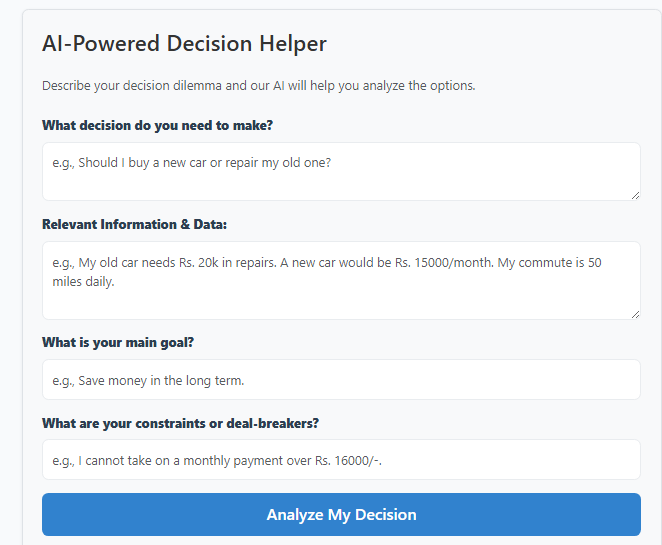How AI Decision-Making Tools Work: The Complete Guide

What Are AI Decision-Making Tools?
This guide explains the functioning of AI decision-making tools in detail.
Feeling stuck? Can’t decide what to do? The Decision Helper is an AI tool that acts like a smart coach to help you think through your choices. It won’t tell you what to do, but will help you see your options clearly.
The Science Behind How AI Decision Tools Work
Step 1: Find the Tool on Our Website
First, log in to your account on our website. Look for a page called “Decision Helper” or “Get Help Deciding.” You might need to purchase access if you can’t find it.
Step 2: Fill Out the Form
You’ll see a form with four boxes to fill out. Be honest and detailed—the better the information you give, the better the advice you’ll get.
Real Examples:
What to write: Briefly state the decision you need to make.
“Should I take a part-time job while school is in session?”
What Key Details Should You Know?
What to write: Add facts, numbers, or details about your decision.
Example: “The job pays Rs. 900/hour.
Working 10 hours a week is my plan.
Each night, I spend about 2 hours on homework.
My goal is to save for a car.
What’s Your Main Goal?
What to write: What is the most important thing you want to achieve?
Example: “I want to save money but still have enough time to keep my grades up.”
What Are Your Limits?
What to write: What are your deal-breakers or rules you can’t change?
Example: “I cannot work on weeknights after 8 PM. I must maintain a B average.”
Step 3: Click “Analyze My Decision”
Once you click the button, our AI tool will get to work. It uses your answers to create a personalized analysis. Please be patient—this usually takes about 10-20 seconds.
Step 4: Review Your Results
The tool will give you a report with several sections:
The Core Problem: A summary of your primary issue.
Key Factors: The most important things for you to think about.
Potential Options: A list of possible choices you have.
Pros and Cons: Each option’s good and bad points are based on your goals and limits.
Next Steps: Ideas for what information you need to find out next.
Remember: This is not the final answer. It’s a tool to help you make a more intelligent, confident decision.
Real Examples: How AI Tools Make Decisions for Students:
Let’s see how a student might use it.
Dilemma: “Should I take AP Biology or regular Biology next year?”
Information: “AP Bio is harder, but looks good on college applications. It has a heavy lab report workload. I’m good at science, but I also play soccer, which takes a lot of time.”
Goal: “Get into a good college without getting too stressed out.”
Constraints: “I need to keep my GPA above 3.5. I can’t spend more than 90 minutes a night on homework for one class.”
The Decision Helper would then break this down, maybe pointing out that AP Bio helps for college but could hurt your GPA and soccer performance if it’s too overwhelming.
Example for Business :
Realistic scenario for a small business owner. You can use this exact text to test the tool.
Dilemma:
Relevant Information:
My growing small business needs a dedicated expert to handle social media (content creation, scheduling, engagement, ads). I spend 10 hours a week on it, which is time I should spend on sales and product development. A full-time employee would cost about Rs. 60,000 per year plus benefits. A reputable marketing agency has quoted me Rs. 2,500 per month (Rs. 30,000 per year) for a similar scope of work. The agency has a team of experts and already has the software and tools. An employee would be 100% dedicated to my brand and could do other small tasks.
Goal:
“I want to improve my social media presence to generate more leads and sales, while freeing up my time and getting the best value for my money.”
Constraints:
The budget for this function is a maximum of Rs. 3,500 per month.
Availability during my core business hours (9 AM – 5 PM EST) is required from the person/team.
Final approval on all content before posting must come from me.
A positive return on investment should be seen within 6 months.
“Should I hire a full-time social media manager or outsource it to a marketing agency?”
Why This is a Good Example for the AI:
Clear Options: It presents two distinct choices (Hire vs. Outsource).
Quantifiable Data includes specific numbers (Rs 60,000 vs. Rs. 30,000, 10 hours).
Strategic Goal: The goal is clear and has multiple parts (generate leads, free up time, get value).
Firm Constraints: The constraints set clear boundaries (budget, availability, ROI timeline).
What the AI Tool Will Do With This:
When you click ‘Analyze,’ the AI will then process this information and then generate a structured report. Based on this example.
Summary of the Core Problem: “You need to delegate social media responsibilities and are weighing the cost, control, and expertise of an in-house hire versus an agency.”
How to Choose the Right AI Decision Tool
Final Tip: Use the tool anytime you feel stuck on a big decision. The more you use it, the better you’ll get at thinking through your choices!
